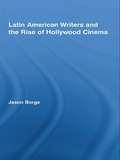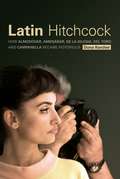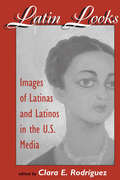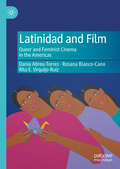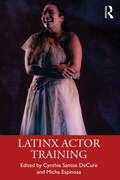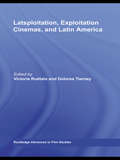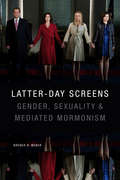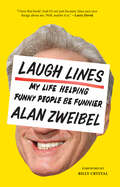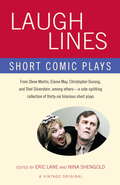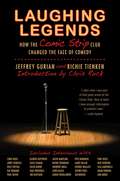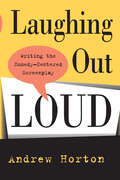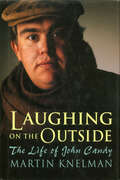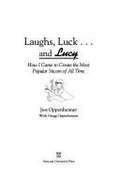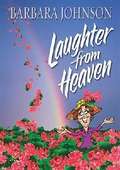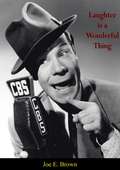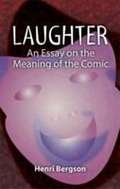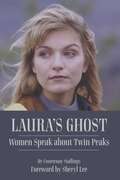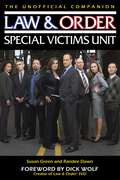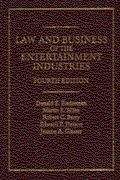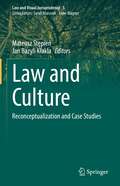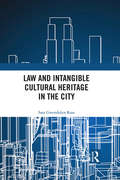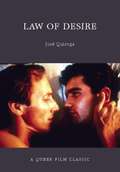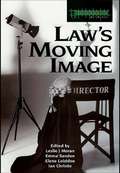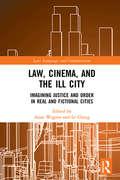- Table View
- List View
Latin American Writers and the Rise of Hollywood Cinema (Routledge Studies in Twentieth-Century Literature)
by Jason BorgeThis book analyzes the initial engagement with Hollywood by key Latin American writers and intellectuals during the first few decades of the 20th century. The film metropolis presented an ambiguous, multivalent sign for established figures like Horacio Quiroga, Alejo Carpentier and Mário de Andrade, as well as less renowned writers like the Mexican Carlos Noriega Hope, the Chilean Vera Zouroff and the Cuban Guillermo Villarronda. Hollywood’s arrival on the scene placed such writers in a bind, as many felt compelled to emulate the "artistry" of a medium dominated by a nation posing a symbolic affront to Latin American cultural and linguistic autonomy as well as the region’s geopolitical sovereignty. The film industry thus occupied a crucial site of conflict and reconciliation between aesthetics and politics.
Latin Hitchcock: How Almodóvar, Amenábar, De la Iglesia, Del Toro and Campanella Became Notorious
by Dona KercherThis study explores how five major Spanish and Latino directors modeled their early careers on Hitchcock and his film aesthetics.
Latin Hitchcock: How Almodóvar, Amenábar, De la Iglesia, Del Toro, and Campanella Became Notorious
by Dona KercherThis study explores how five major directors—Pedro Almodóvar, Alejandro Amenábar, Alex de la Iglesia, Guillermo del Toro, and Juan José Campanella—modeled their early careers on Hitchcock and his film aesthetics. In shadowing Hitchcock, their works embraced the global aspirations his movies epitomize. Each section of the book begins with an extensive study, based on newspaper accounts, of the original reception of Hitchcock's movies in either Spain or Latin America and how local preferences for genre, glamour, moral issues, and humor affected their success. The text brings a new approach to world film history, showcasing both the commercial and artistic importance of Hitchcock in Spain and Latin America
Latin Looks: Images of Latinas and Latinos in the U.S. Media
by Clara E RodriguezWhat are “Latin looks”? A Latin look may seem at first blush to be something that everyone recognizes—brunette, sensual, expressive, animated, perhaps threatening. But upon reflection, we realize that these are the images that are prevalent in the media, while the reality in Latino communities is of a rich diversity of people and images. This book brings together a selection of the best, the most interesting, and the most analytically sophisticated writing on how Latinos have been portrayed in movies, television, and other media since the early years of the twentieth century and how images have changed over time in response to social and political change. Particular emphasis is given to representations of class, gender, color, race, and the political relationship between the United States and Latin America. Together the essays offer a corrective lens for interpreting how images are created, perpetuated, and manipulated.
Latinidad and Film: Queer and Feminist Cinema in the Americas
by Rosana Blanco-Cano Dania Abreu-Torres Rita E. Urquijo-RuizThis book provides an analysis of Latinidad in Latin American and U.S. Latinx films by women and/or LGBTQ directors from 1991 to 2016. Challenging traditional notions of gender roles, family, and national identities, it discusses how film directors are broadening the canon and producing provocative work that challenges the boundaries of identity. Utilizing a feminist and queer lens, this book is intended to demonstrate the dynamic interactions between individual agency, choices, and freedom from the communities represented. The book's organization in three parts reflects a common core of the Latin American and U.S. Latinx experiences, unifying all these films in the hope of creating a better understanding of these geographical regions and their people.
Latinx Actor Training
by Cynthia Santos DeCure Micha EspinosaLatinx Actor Training presents essays and pioneering research from leading Latinx practitioners and scholars in the United States to examine the history and future of Latino/a/x/e actor training practices and approaches. Born out of the urgent need to address the inequities in academia and the industry as Latinx representation on stage and screen remains disproportionately low despite population growth; this book seeks to reimagine and restructure the practice of actor training by inviting deep investigation into heritage and identity practices. Latinx Actor Training features contributions covering current and historical acting methodologies, principles, and training, explorations of linguistic identity, casting considerations, and culturally inclusive practices that aim to empower a new generation of Latinx actors and to assist the educators who are entrusted with their training. This book is dedicated to creating career success and championing positive narratives to combat pervasive and damaging stereotypes. Latinx Actor Training offers culturally inclusive pedagogies that will be invaluable for students, practitioners, and scholars interested in the intersections of Latinx herencia (heritage), identity, and actor training.
Latsploitation, Exploitation Cinemas, and Latin America (Routledge Advances in Film Studies)
by Dolores Tierney Victoria RuétaloExploring the much neglected area of Latin American exploitation cinema, this anthology challenges established continental and national histories and canons which often exclude exploitation cinema due to its perceived ‘low’ cultural status. It argues that Latin American exploitation cinema makes an important aesthetic and social contribution to the larger body of Latin American cinema – often competing with Hollywood and more mainstream national cinemas in terms of popularity.
Latter-day Screens: Gender, Sexuality, and Mediated Mormonism
by Brenda R. WeberFrom Sister Wives and Big Love to The Book of Mormon on Broadway, Mormons and Mormonism are pervasive throughout American popular media. In Latter-day Screens, Brenda R. Weber argues that mediated Mormonism contests and reconfigures collective notions of gender, sexuality, race, spirituality, capitalism, justice, and individualism. Focusing on Mormonism as both a meme and an analytic, Weber analyzes a wide range of contemporary media produced by those within and those outside of the mainstream and fundamentalist Mormon churches, from reality television to feature films, from blogs to YouTube videos, and from novels to memoirs by people who struggle to find agency and personhood in the shadow of the church's teachings. The broad archive of mediated Mormonism contains socially conservative values, often expressed through neoliberal strategies tied to egalitarianism, meritocracy, and self-actualization, but it also offers a passionate voice of contrast on behalf of plurality and inclusion. In this, mediated Mormonism and the conversations on social justice that it fosters create the pathway toward an inclusive, feminist-friendly, and queer-positive future for a broader culture that uses Mormonism as a gauge to calibrate its own values.
Laugh Lines: My Life Helping Funny People Be Funnier
by Alan ZweibelWith his tender, funny memoir of four decades in the business, one of the first writers for Saturday Night Live traces the history of American comedy. Alan Zweibel started his comedy career selling jokes for seven dollars apiece to the last of the Borscht Belt standups. Then one night, despite bombing on stage, he caught the attention of Lorne Michaels and became one of the first writers at Saturday Night Live, where he penned classic material for Gilda Radner, John Belushi, and all of the original Not Ready For Prime Time Players. From SNL, he went on to have a hand in a series of landmark shows—from It’s Garry Shandling’s Show to Curb Your Enthusiasm. Throughout the pages of Laugh Lines Zweibel weaves together his own stories and interviews with his friends and contemporaries, including Richard Lewis, Eric Idle, Bob Saget, Mike Birbiglia, Sarah Silverman, Judd Apatow, Dave Barry, Carl Reiner, and more. The book also features a charming foreword from his friend of forty-five years Billy Crystal, with whom he co-wrote and co-produced the upcoming film Here Today that stars Crystal and Tiffany Haddish. Laugh Lines is a warmhearted cultural memoir of American comedy.“In Laugh Lines, Zweibel looks back, affectionately and informatively, at a career that began when he was a young deli worker grinding out jokes for old-school borscht belt comedians in his spare time, and that, after his “S.N.L.” years, included rewarding collaborations with, among others, Garry Shandling, Billy Crystal, Martin Short, Larry David and Dave Barry. . . . Fascinating.” —New York Times“Any comedy fan will thrill to see the contemporary art's invention through the eyes of consummate funny man Alan Zweibel. He takes you behind the velvet rope and makes you weep for all those artists who made us laugh. Screamingly funny—also very moving. A classic.” —Mary Karr“Alan Zweibel is legendary among us comedians. He is the man who delivers comedy with an emotional clout that makes him respected and revered.” —Steve Martin
Laugh Lines: Short Comic Plays
by Eric Lane Nina ShengoldThis one-of-a-kind anthology features thirty-six hilarious short plays by major American playwrights and emerging new voices, all guaranteed to send readers and audiences into peals of laughter. From the surrealistic wit of Steve Martin's "The Zig-Zag Woman" to the biting political satire of Steven Dietz's "The Spot," from Christopher Durang's wonderfully loopy "Wanda's Visit" to Shel Silverstein's supremely twisted "The Best Daddy," there's something in here to make everyone laugh. There are plays for casts of all sizes, from monologues to large ensembles, with diverse and challenging roles for actors of every age and type. Even the titles are funny: Mark O'Donnell's "There Shall Be No Bottom (a bad play for worse actors)," Elaine May's "The Way of All Fish," and Alan Ball's "Your Mother's Butt. " A bonanza for theatergoers, performers, and comedy fans,Laugh Lineswill bring down the house. From the Trade Paperback edition.
Laughing Legends: How The Comic Strip Club Changed The Face of Comedy
by Chris Rock Jeffrey Gurian Richie TienkenOnce in a lifetime a venue comes along that changes show business dramatically, that fosters growth and camaraderie, experimentation and freedom. The Comic Strip is one of those places, and Laughing Legends is an inside look at how it all happened, straight from the mouths of the stars who built their careers on its stage. Owner Richie Tienken and a wealth of comics open their hearts and souls to share their most intimate memories, the laughs and tears, the good times and the bad, in order to paint an all-encompassing, behind-the-scenes history of this iconic club. Interviews include famous comedians, such as:Jerry SeinfeldGilbert GottfriedPaul ReiserLisa LampanelliGeorge WallaceBilly CrystalJim BreuerSusie EssmanLewis BlackRay RomanoAnd many more!Relive the excitement as these comics explain how they came to belong to the Comic Strip family, and how they went on to enjoy huge careers, bringing laughter to millions of people all over the world. This book is a must for any comedian or comedy lover's library!
Laughing Out Loud: Writing the Comedy-Centered Screenplay
by Andrew HortonWhoever wrote "Make 'em laugh!" knew that it's easier said than done. But people love to laugh, and good comedy will always sell. With the help of this complete and entertaining guide, writers and would-be writers for film and television can look forward to writing comedy that goes far beyond stereotypic jokes and characters. In Laughing Out Loud, award-winning screenwriter and author Andrew Horton blends history, theory, and analysis of comedy with invaluable advice.Using examples from Chaplin to Seinfeld, Aristophanes to Woody Allen, Horton describes comedy as a perspective rather than merely as a genre and then goes on to identify the essential elements of comedy. His lively overview of comedy's history traces its two main branches—anarchistic comedy and romantic comedy—from ancient Greece through contemporary Hollywood, by way of commedia dell'arte, vaudeville, and silent movies. Television and international cinema are included in Horton's analysis, which leads into an up-close review of the comedy chemistry in a number of specific films and television shows.The rest of the book is a practical guide to writing feature comedy and episodic TV comedy, complete with schedules and exercises designed to unblock any writer's comic potential. The appendices offer tips on networking, marketing, and even producing comedies, and are followed by a list of recommended comedies and a bibliography.
Laughing on the Outside: The Life of John Candy
by Martin Knelman“A truthful look at John Candy—affectionate but unblinking.” —San Francisco ExaminerFunny and gentle, John Candy was loved by millions of movie fans for playing true-to-life characters. Whether as the irrepressible bon vivant in Splash, the misunderstood slob in Uncle Buck, or the generous lonely salesman in Planes, Trains, and Automobiles, John Candy struck a perfect balance between self-deprecating humor and irresistible, emotional warmth. In this compassionate portrait of John Candy, award-winning journalist Martin Knelman reveals that behind the scenes, beneath the booming laughter, a man blessed by genius and goodness of heart was ultimately and sadly undermined by self-doubt and misguided ambition.“Laughing on the Outside celebrates the genius of John Candy.” —Vanity Fair“Candy’s is ultimately a sad story, one that Knelman has made sympathetic and memorable, too.” —Booklist“This book is a must for Candy’s fans and an ought-to for everyone else.” —Toronto Globe and Mail“Everyone knew the happy-go-lucky comic, but Knelman shows us the sad clown underneath, which ultimately enriches the image.” —Toronto Star
Laughs, Luck...and Lucy: How I Came to Create the Most Popular Sitcom of All Time
by Jess Oppenheimer Gregg OppenheimerLaughs indeed as Jess Oppenheimer charts his rise from radio station gofer to inventor of the sitcom, as he winds up writing--then producing--Lucille Ball's show, first on radio, then on television. Luck, too, as the author recounts the good fortune that has him, within minutes of arrival in Hollywood, sitting down at a lunch counter and getting a tip that secures a job within days and a career for life. Ironic, too, that this inveterate TV writer had to be cajoled for years to set down these Hollywood heyday memoirs. He never finished, and it was left to son Gregg to complete the book.
Laughter from Heaven
by Barbara JohnsonLaughter from Heaven is a joyful reminder of the wonderful life awaiting us in heaven. With her humorous approach to all life's circumstances, Barbara wants her readers to catch a light-hearted look at the hereafter. Filled with hope and encouragement, this book is sure to become a favorite of many women who long for a sense of joy in the midst of everyday struggles. In classic Barbara Johnson style, these hilarious pages will show you how to put life's trials into heavenly perspective. She hopes you will find encouragement through your difficulties, renewal for your spiritual doldrums, and laughter when you think you'll never laugh again. Similar in nature to her best-selling title Humor Me, this delightful look at heaven reveals it as a place that will be not only without pain, but will actually be fun! Jokes, stories, cartoons and Barbara's famous one-liners make this another joy-filled book that all her fans will love. Picture captions and descriptions present.
Laughter is a Wonderful Thing
by Joe E. Brown Ralph HancockHOW ONE MAN FOUND A WAY OF LAUGHTER AND GAVE IT TO THE WORLDEvery American has at one time or another known the pleasure of watching Joe E. Brown. Mirth-maker Joe, clown-prince of movies, radio and TV, however, is more than just a dispenser of gaiety and laughter.Ralph Hancock, famed foreign correspondent, has drawn a most accurate picture of one of the country’s outstanding citizens. You’ll laugh with, and feel sympathy for comedian Joe—the grease-painted Pagliacci of the footlights—as you read of a lifetime of all the human emotions.Joe E. Brown was born to bring laughter into the world. From the first day he realized people enjoyed him, he knew he was meant to continue in his role as self-appointed Ambassador of goodwill. Joe’s formula was simple and refreshing: Always leave ‘em laughing, even before you say goodbye.Co-author Hancock skilfully weaves a heart-warming tale of a humourist but—more important—a humanitarian who has never hesitated to cooperate with a cause which is pledged to the advancement of the human race.Laughter may be a wonderful thing, but it is also the tender tale of a father who knows the pleasures and sorrows of raising a family. The story of Joe E. Brown is a lifelike portrait of one of America’s most beloved personalities.
Laughter: An Essay on the Meaning of the Comic
by Henri BergsonIn this great philosophical essay, Henri Bergson explores why people laugh and what laughter means. Written at the turn of the twentieth century, Laughter explores what it is in language that makes a joke funny and what it is in us that makes us laugh. One of the functions of humor, according to Bergson, is to help us retain our humanity during an age of mechanization. Like other philosophers, novelists, poets, and humorists of his era, Bergson was concerned with the duality of man and machine. His belief in life as a vital impulse, indefinable by reason alone, informs his perception of comedy as the relief we experience upon distancing ourselves from the mechanistic and materialistic. "A situation is always comic," Bergson notes, "if it participates simultaneously in two series of events which are absolutely independent of each other, and if it can be interpreted in two quite different meanings. " The philosopher's thought-provoking insights (e. g. , "It seems that laughter needs an echo. Our laughter is always the laughter of a group. ") keep this work ever-relevant as a thesis on the principles of humor.
Laura's Ghost: Women Speak About Twin Peaks
by Courtenay StallingsThis incredibly powerful book by media professor Courtenay Stallings explores the dark side of Twin Peaks through interviews with fans of the show who've experienced trauma in their own lives and worked through it with assistance from the character of Laura Palmer. In 1990, the groundbreaking television series Twin Peaks, cocreated by David Lynch and Mark Frost, opened with a murder mystery when a homecoming queen washed up on a rocky beach. Laura Palmer&’s character began as a plot device that triggered a small town to face its fractured self. After three seasons and a film, Laura Palmer is no longer just a plot device. Twin Peaks allows the audience to get to know the victim—a complex woman finding her strength while enduring incredible trauma. Laura&’s Ghost: Women Speak about Twin Peaks explores Laura&’s legacy through the perspectives of women in the fan community and women involved in the show. Actor Sheryl Lee examines the challenges of playing Laura Palmer. Filmmaker Jennifer Lynch discusses writing Laura&’s backstory in The Secret Diary of Laura Palmer. Grace Zabriskie argues about the complicity of Sarah Palmer, Laura&’s mother. Sabrina S. Sutherland, executive producer of Twin Peaks, talks about Laura&’s legacy. Women in the Twin Peaks fan community share their powerful and heart-wrenching stories of survival and what Laura Palmer means to them. This book is a reckoning in which women speak about trauma, mischief, humor, sexuality, strength, weakness, wickedness, and survival.
Law & Order: Special Victims Unit Unofficial Companion
by Susan Green Randee DawnThe Law & Order: Special Victims Unit Unofficial Companion is a comprehensive guide covering the first 10 seasons and includes a synopsis and an objective analysis for each episode, as well as commentaries or recollections from the people involved in crafting the one-hour tale. It goes after the heart of SVU through interviews with actors, writers, producers, casting agents, location scouts and others. The authors peek behind the scenes of the bicoastal operation, observing the progress of an entire episode shot in New York City and a script fine-tuned in Los Angeles. The book provides fascinating insight, delighting SVU devotees who love on-screen and backstage trivia. In addition, creator Dick Wolf offers readers a gripping foreword to the book.
Law and Business of the Entertainment Industries: Fourth Edition
by Donald E. Biederman Martin E. Silfen Robert C. Berry Edward P. Pierson Jeanne A. GlasserThis edition is divided into two parts--one dealing with general principles and the other dealing with specific entertainment and related industries.
Law and Culture: Reconceptualization and Case Studies (Law and Visual Jurisprudence #5)
by Mateusz Stępień Jan Bazyli KlaklaDivided into three parts, this book examines the relationship between law and culture from various perspectives, both theoretical and empirical. Part I outlines the framework for further considerations and includes new, innovative conceptualizations of two ideas that are essential to the topic of law and culture: legal culture and customary law. Both of these reappear later in the more empirically oriented chapters of Parts II and III. Part II includes chapters on the relationships between law, customs, and culture, drawing heavily on the tradition and achievements of the anthropology of law and touching on important problems of multiculturalism, legal pluralism, and cultural defense. It focuses on the more intangible meaning of culture, while Part III addresses its more material, tangible aspects and the issue of cultural production, as well as its intersection with law.
Law and Intangible Cultural Heritage in the City
by Sara Gwendolyn RossWith disappearing music venues, and arts and culture communities at constant risk of displacement in our urban centers, the preservation of intangible cultural heritage is of growing concern to global cities. This book addresses the role and protection of intangible cultural heritage in the urban context. Using the methodology of Urban Legal Anthropology, the author provides an ethnographic account of the civic effort of Toronto to become a Music City from 2014-18 in the context of redevelopment and gentrification pressures. Through this, the book elucidates the problems cities like Toronto have in equitably protecting intangible cultural heritage and what can be done to address this. It also evaluates the engagement that Toronto and other cities have had with international legal frameworks intended to protect intangible cultural heritage, as well as potential counterhegemonic uses of hegemonic legal tools. Understanding urban intangible cultural heritage and the communities of people who produce it is of importance to a range of actors, from urban developers looking to formulate livable and sustainable neighbourhoods, to city leaders looking for ways in which their city can flourish, to scholars and individuals concerned with equitability and the right to the city. This book is the beginning of a conservation about what is important for us to protect in the city for future generations beyond built structures, and the role of intangible cultural heritage in the creation of full and happy lives. The book is of interest to legal and sociolegal readers, specifically those who study cities, cultural heritage law, and legal anthropology.
Law of Desire: A Queer Film Classic
by José QuirogaLaw of Desire, one of three inaugural titles in Arsenal Pulp Press' new film book series Queer Film Classics, focuses on the 1987 homoerotic melodrama by Pedro Almodóvar, Spain's most successful contemporary film director.<P> The film Law of Desire is a grand tale of love, lust, and amnesia featuring three main characters: a gay film director (played by Eusebio Poncela); his sister, an actress who was once his brother (Carmen Maura); and a repressed, obsessive stalker (a young Antonio Banderas). In the twenty-plus years since its first release, Law of Desire has been acknowledged as redefining the way in which cinema can portray the difficult affective relationships between homosexuality, gender, and sex. Taking his cue from the golden age of Latin American, American, and European melodrama, Almodóvar created a sentimental yet hard-edged film that believes in the utopian possibilities for new relationships that redeem people from their despair. Since its release, Almodóvar has become an Oscar-winning filmmaker who regularly delves into issues of sexuality, gender, and identity.<P> This book examines the political and social context in which Almodóvar created Law of Desire, as well as its impact on LGBT cinema both in Europe and around the world.
Law's Moving Image
by Ian Christie Elena Loizidou Leslie J Moran Emma SandonThis book is an essential introduction to the complex issues and debates in the field of law and film. It explores interconnections that are usually ignored between law and film through three main themes: A Fantastic Jurisprudence explores representations of law in law Law, Aesthetics and Visual Technologies focuses on the visual aspects of law's moving image Regulation: Histories, Cultures, Practices brings together work on different dimensions and contexts of regulation, censorship, state subsidies and intellectual property to explore the complex inter-relationship between the state, industry and private regulation. Law's Moving Image is an innovative, multi-disciplinary contribution to the rapidly growing fields of study in law and film, law and visual culture, law and culture, criminology, social and cultural studies. It will be of interest to students and academics involved in these areas.
Law, Cinema, and the Ill City: Imagining Justice and Order in Real and Fictional Cities (Law, Language and Communication)
by Anne Wagner Le ChengThis book uses film and television as a resource for addressing the social and legal ills of the city. It presents a range of approaches to view the ill city through cinematic and televisual characterization in urban frameworks, political contexts, and cultural settings. Each chapter deconstructs the meaning of urban space as public space while critically generating a focus on order and justice, exploring issues such as state disorder, lawlessness, and revenge. The approach presents a careful balance between theory and application. The original and novel ideas presented in this book will be essential reading for those interested in the presentation of law and place in cultural texts such as film.
